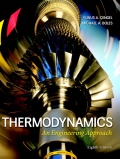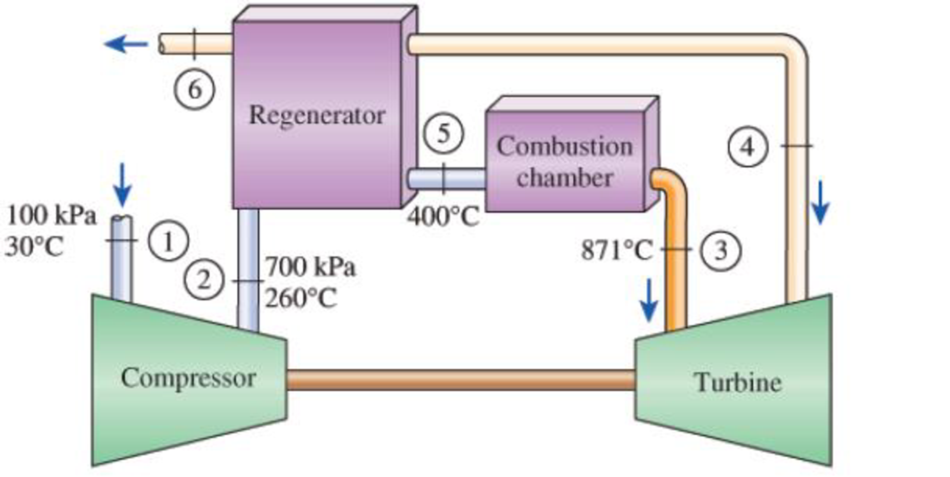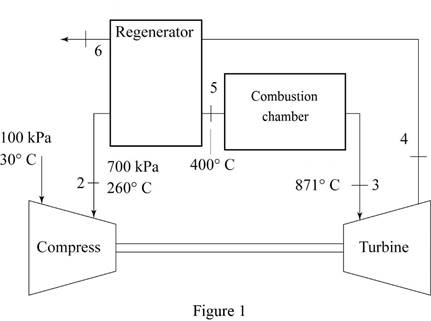
A gas-turbine power plant operates on the regenerative Brayton cycle between the pressure limits of 100 and 700 kPa. Air enters the compressor at 30°C at a rate of 12.6 kg/s and leaves at 260°C. It is then heated in a regenerator to 400°C by the hot combustion gases leaving the turbine. A diesel fuel with a heating value of 42,000 kJ/kg is burned in the combustion chamber with a combustion efficiency of 97 percent. The combustion gases leave the combustion chamber at 871°C and enter the turbine, whose isentropic efficiency is 85 percent. Treating combustion gases as air and using constant specific heats at 500°C, determine (a) the isentropic efficiency of the compressor, (b) the effectiveness of the regenerator, (c) the air–fuel ratio in the combustion chamber, (d) the net power output and the back work ratio, (e) the thermal efficiency, and (f) the second-law efficiency of the plant. Also determine (g) the second-law efficiencies of the compressor, the turbine, and the regenerator, and (h) the rate of the exergy flow with the combustion gases at the regenerator exit.

a)
The isentropic efficiency of the compressor.
Answer to Problem 148P
The isentropic efficiency of the compressor is
Explanation of Solution
Draw the layout of the gas-turbine plant functioning on the regenerative Brayton cycle as shown in Figure (1).

Consider, the pressure is
Write the expression to calculate the temperature and pressure relation ratio for the isentropic compression process 1-2s.
Here, the specific heat ratio is k.
Write the expression to calculate the isentropic efficiency of the compressor
Write the expression to calculate the temperature and pressure relation ratio for the expansion process 3-4s.
Write the expression for the isentropic efficiency of the turbine
Conclusion:
From Table A-2b, “Ideal-gas specific heats of various common gases”, obtain the following values of air at
Substitute 303 K for
Substitute 303 K for
Thus, the isentropic efficiency of the compressor is
Substitute 1144 K for
Substitute 1144 K for
b)
The effectiveness of the regenerator for regenerative Brayton cycle.
Answer to Problem 148P
The effectiveness of the regenerator for regenerative Brayton cycle is
Explanation of Solution
Write the expression to calculate the effectiveness of the regenerator
Conclusion:
Substitute 673 K for
Thus, the effectiveness of the regenerator for regenerative Brayton cycle is
c)
The air-fuel ratio in the combustion chamber.
Answer to Problem 148P
The air-fuel ratio in the combustion chamber is
Explanation of Solution
Write the expression for the heat input for the regenerative Brayton cycle
Here, the specific heat at constant pressure is
Write the expression to calculate the air-fuel ratio in the combustion chamber (AF).
Write the expression to calculate the total mass of the air-fuel mixture
Write the expression to calculate the heat input for the regenerative cycle
Conclusion:
Substitute
Substitute
Thus, the air-fuel ratio in the combustion chamber is
Substitute
Substitute
d)
The net power developed by the gas-turbine plant and the back work ratio for the gas-turbine plant.
Answer to Problem 148P
The net power developed by the gas-turbine plant is
The back work ratio for the gas-turbine plant is
Explanation of Solution
Write the expression to calculate the power given to the compressor
Write the expression to calculate the power developed by the turbine
Write the expression to calculate the net power developed by the gas-turbine plant
Write the expression to calculate the back work ratio for the gas-turbine plant
Conclusion:
Substitute
Substitute
Substitute 3168 kW for
Thus, the net power developed by the gas-turbine plant is
Substitute 3168 kW for
Thus, the back work ratio for the gas-turbine plant is
e)
The thermal efficiency of the gas-turbine plant.
Answer to Problem 148P
The thermal efficiency of the gas-turbine plant is
Explanation of Solution
Write the expression to calculate the thermal efficiency of the gas-turbine plant
Conclusion:
Substitute 2266 kW for
Thus, the thermal efficiency of the gas-turbine plant is
f)
The second-law efficiency of the gas-turbine plant.
Answer to Problem 148P
The second-law efficiency of the gas-turbine plant is
Explanation of Solution
Write the expression to calculate the second-law efficiency of the gas-turbine plant
Here, the maximum possible efficiency of the gas-turbine plant is
Write the expression to calculate the maximum possible efficiency of the gas-turbine plant.
Conclusion:
Substitute 303 K for
Substitute 0.735 for
Thus, the second-law efficiency of the gas-turbine plant is
g)
The exergy efficiency for compressor , turbine and regenerator.
Answer to Problem 148P
The exergy efficiency for the compressor is
The exergy efficiency for the turbine is
The exergy efficiency for the regenerator is
Explanation of Solution
Write the expression to calculate the stream exergy difference between the inlet and exit of the compressor
Here, the temperature of the surroundings is
Write the expression to calculate the exergy efficiency for the compressor
Write the expression to calculate the stream exergy difference between the inlet and exit of the turbine
Write the expression to calculate the exergy efficiency for the turbine
Applying energy balance for the regenerator process.
Write the expression to calculate the exergy increase of the cold fluid for the regenerator
Write the expression to calculate the exergy decrease of the cold fluid for the regenerator
Write the expression to calculate the exergy efficiency for the regenerator
Conclusion:
Substitute
Substitute
Thus, the exergy efficiency for the compressor is
Substitute
Substitute
Thus, the exergy efficiency for the turbine is
substitute
Substitute
Substitute
Substitute
Thus, the exergy efficiency for the regenerator is
h)
The rate of exergy of the combustion gases at the regenerator exit.
Answer to Problem 148P
The rate of exergy of the combustion gases at the regenerator exit is
Explanation of Solution
Write the expression to calculate the rate of exergy of the combustion gases at the regenerator exit
Conclusion:
Substitute
Thus, the rate of exergy of the combustion gases at the regenerator exit is
Want to see more full solutions like this?
Chapter 9 Solutions
EBK THERMODYNAMICS: AN ENGINEERING APPR
- Consider a large 6-cm-thick stainless steel plate (k = 15.1 W/m-K) in which heat is generated uniformly at a rate of 5 × 105 W/m³. Both sides of the plate are exposed to an environment at 30°C with a heat transfer coefficient of 60 W/m²K. Determine the value of the highest and lowest temperature. The highest temperature is The lowest temperature is °C. °C.arrow_forwardSketch and explain a PV Diagram and a Temperature Entropy Diagram for a 4 stroke diesel engine please, please explain into detail the difference bewteen the two and referance the a diagram. Please include a sketch or an image of each diagramarrow_forwardDraw left view of the first orthographic projectionarrow_forward
- Sketch and Describe a timing diagram for a 2 stroke diesel engine emphasis on the 2 stroke as my last answer explained 4 stroke please include a diagram or sketch.arrow_forwardA 4 ft 200 Ib 1000 Ib.ft C 2 ft 350 Ib - за в 2.5 ft 150 Ib 250 Ib 375 300 Ib Replace the force system acting on the frame. shown in the figure by a resultant force (magnitude and direction), and specify where its line of action intersects member (AB), measured from point (A).arrow_forwardA continuous flow calorimeter was used to obtain the calorific value of a sample of fuel and the following data collected: Mass of fuel: 2.25 kgInlet water temperature: 11 ° COutlet water temperature 60 ° CQuantity of water: 360 Liters Calorimeter efficiency: 85%Calculate the calorific value of the sample ( kJ / kg ). ive submitted this question twice and have gotten two way different answers. looking for some help thanksarrow_forward
- 15 kg of steel ball bearings at 100 ° C is immersed in 25 kg of water at 20 ° C . Assuming no loss of heat to or from the container, calculate the final temperature of the water after equilibrium has been attained.Specific heat of steel: 0.4857 kJ / kg / ° KSpecific heat of water: 4.187 kJ / kg / ° Karrow_forwardSketch and explain a PV Diagram and a Temperature Entropy Diagram for a 4 stroke diesel enginearrow_forwardA continuous flow calorimeter was used to obtain the calorific value of a sample of fuel and the following data collected: Mass of fuel: 2.25 kgInlet water temperature: 11 ° COutlet water temperature 60 ° CQuantity of water: 360 Liters Calorimeter efficiency: 85%Calculate the calorific value of the sample ( kJ / kg ).arrow_forward
- Chapter 12 - Lecture Notes.pptx: (MAE 272-01) (SP25) DY... Scoresarrow_forwardmylabmastering.pearson.com Chapter 12 - Lecture Notes.pptx: (MAE 272-01) (SP25) DY... P Pearson MyLab and Mastering Scoresarrow_forwardanswer the fallowing Brake Specific Fuel Consumption - 0.3 kg/kwh, Mechanical Efficiency- 90% Calorific Value of Fuel -45 MJ/kg. Given these values, find the indicated power, indicated thermal efficiency and brake thermal efficiencyarrow_forwardarrow_back_iosSEE MORE QUESTIONSarrow_forward_iosRecommended textbooks for you
 Elements Of ElectromagneticsMechanical EngineeringISBN:9780190698614Author:Sadiku, Matthew N. O.Publisher:Oxford University Press
Elements Of ElectromagneticsMechanical EngineeringISBN:9780190698614Author:Sadiku, Matthew N. O.Publisher:Oxford University Press Mechanics of Materials (10th Edition)Mechanical EngineeringISBN:9780134319650Author:Russell C. HibbelerPublisher:PEARSON
Mechanics of Materials (10th Edition)Mechanical EngineeringISBN:9780134319650Author:Russell C. HibbelerPublisher:PEARSON Thermodynamics: An Engineering ApproachMechanical EngineeringISBN:9781259822674Author:Yunus A. Cengel Dr., Michael A. BolesPublisher:McGraw-Hill Education
Thermodynamics: An Engineering ApproachMechanical EngineeringISBN:9781259822674Author:Yunus A. Cengel Dr., Michael A. BolesPublisher:McGraw-Hill Education Control Systems EngineeringMechanical EngineeringISBN:9781118170519Author:Norman S. NisePublisher:WILEY
Control Systems EngineeringMechanical EngineeringISBN:9781118170519Author:Norman S. NisePublisher:WILEY Mechanics of Materials (MindTap Course List)Mechanical EngineeringISBN:9781337093347Author:Barry J. Goodno, James M. GerePublisher:Cengage Learning
Mechanics of Materials (MindTap Course List)Mechanical EngineeringISBN:9781337093347Author:Barry J. Goodno, James M. GerePublisher:Cengage Learning Engineering Mechanics: StaticsMechanical EngineeringISBN:9781118807330Author:James L. Meriam, L. G. Kraige, J. N. BoltonPublisher:WILEY
Engineering Mechanics: StaticsMechanical EngineeringISBN:9781118807330Author:James L. Meriam, L. G. Kraige, J. N. BoltonPublisher:WILEY
 Elements Of ElectromagneticsMechanical EngineeringISBN:9780190698614Author:Sadiku, Matthew N. O.Publisher:Oxford University Press
Elements Of ElectromagneticsMechanical EngineeringISBN:9780190698614Author:Sadiku, Matthew N. O.Publisher:Oxford University Press Mechanics of Materials (10th Edition)Mechanical EngineeringISBN:9780134319650Author:Russell C. HibbelerPublisher:PEARSON
Mechanics of Materials (10th Edition)Mechanical EngineeringISBN:9780134319650Author:Russell C. HibbelerPublisher:PEARSON Thermodynamics: An Engineering ApproachMechanical EngineeringISBN:9781259822674Author:Yunus A. Cengel Dr., Michael A. BolesPublisher:McGraw-Hill Education
Thermodynamics: An Engineering ApproachMechanical EngineeringISBN:9781259822674Author:Yunus A. Cengel Dr., Michael A. BolesPublisher:McGraw-Hill Education Control Systems EngineeringMechanical EngineeringISBN:9781118170519Author:Norman S. NisePublisher:WILEY
Control Systems EngineeringMechanical EngineeringISBN:9781118170519Author:Norman S. NisePublisher:WILEY Mechanics of Materials (MindTap Course List)Mechanical EngineeringISBN:9781337093347Author:Barry J. Goodno, James M. GerePublisher:Cengage Learning
Mechanics of Materials (MindTap Course List)Mechanical EngineeringISBN:9781337093347Author:Barry J. Goodno, James M. GerePublisher:Cengage Learning Engineering Mechanics: StaticsMechanical EngineeringISBN:9781118807330Author:James L. Meriam, L. G. Kraige, J. N. BoltonPublisher:WILEY
Engineering Mechanics: StaticsMechanical EngineeringISBN:9781118807330Author:James L. Meriam, L. G. Kraige, J. N. BoltonPublisher:WILEY